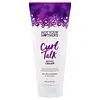What's inside
What's inside
 Benefits
Benefits

 Concerns
Concerns

 Ingredients Side-by-side
Ingredients Side-by-side

Water
Skin ConditioningPolyacrylamide
C13-14 Isoparaffin
EmollientShea Butter Ethyl Esters
EmollientPolyquaternium-10
Lactobacillus/Tomato Fruit Ferment Extract
Skin ConditioningOryza Sativa Extract
AbsorbentKeratin Amino Acids
Skin ConditioningLeuconostoc/Radish Root Ferment Filtrate
AntimicrobialAcyl Coenzyme A Desaturase
Skin ConditioningLaureth-7
EmulsifyingPg-Hydroxyethylcellulose Cocodimonium Chloride
Parfum
MaskingDisodium EDTA
Phenoxyethanol
PreservativeEthylhexylglycerin
Skin ConditioningWater, Polyacrylamide, C13-14 Isoparaffin, Shea Butter Ethyl Esters, Polyquaternium-10, Lactobacillus/Tomato Fruit Ferment Extract, Oryza Sativa Extract, Keratin Amino Acids, Leuconostoc/Radish Root Ferment Filtrate, Acyl Coenzyme A Desaturase, Laureth-7, Pg-Hydroxyethylcellulose Cocodimonium Chloride, Parfum, Disodium EDTA, Phenoxyethanol, Ethylhexylglycerin
Water
Skin ConditioningCetearyl Alcohol
EmollientBehentrimonium Chloride
PreservativeCetyl Alcohol
EmollientStearyl Alcohol
EmollientLimnanthes Alba Seed Oil
Skin ConditioningCaprylic/Capric Triglyceride
MaskingOlea Europaea Fruit Oil
MaskingPersea Gratissima Oil
Skin ConditioningCetyl Esters
EmollientGuar Hydroxypropyltrimonium Chloride
Skin ConditioningPotassium Sorbate
PreservativeCocoyl Hydrolyzed Quinoa Protein
Hydrolyzed Rice Protein
Skin ConditioningPanthenyl Hydroxypropyl Steardimonium Chloride
Brassica Campestris/Aleurites Fordi Oil Copolymer
Skin ConditioningCocos Nucifera Oil
MaskingRubus Idaeus Fruit Extract
AstringentPelargonium Graveolens Extract
MaskingChamomilla Recutita Flower Extract
MaskingAnanas Sativus Fruit Extract
Skin ConditioningCitric Acid
BufferingLinum Usitatissimum Seed Oil
PerfumingSodium Citrate
BufferingPhenoxyethanol
PreservativeEthylhexylglycerin
Skin ConditioningOryza Sativa Bran Oil
EmollientParfum
MaskingWater, Cetearyl Alcohol, Behentrimonium Chloride, Cetyl Alcohol, Stearyl Alcohol, Limnanthes Alba Seed Oil, Caprylic/Capric Triglyceride, Olea Europaea Fruit Oil, Persea Gratissima Oil, Cetyl Esters, Guar Hydroxypropyltrimonium Chloride, Potassium Sorbate, Cocoyl Hydrolyzed Quinoa Protein, Hydrolyzed Rice Protein, Panthenyl Hydroxypropyl Steardimonium Chloride, Brassica Campestris/Aleurites Fordi Oil Copolymer, Cocos Nucifera Oil, Rubus Idaeus Fruit Extract, Pelargonium Graveolens Extract, Chamomilla Recutita Flower Extract, Ananas Sativus Fruit Extract, Citric Acid, Linum Usitatissimum Seed Oil, Sodium Citrate, Phenoxyethanol, Ethylhexylglycerin, Oryza Sativa Bran Oil, Parfum
Ingredients Explained
These ingredients are found in both products.
Ingredients higher up in an ingredient list are typically present in a larger amount.
Ethylhexylglycerin (we can't pronounce this either) is commonly used as a preservative and skin softener. It is derived from glyceryl.
You might see Ethylhexylglycerin often paired with other preservatives such as phenoxyethanol. Ethylhexylglycerin has been found to increase the effectiveness of these other preservatives.
Parfum is a catch-all term for an ingredient or more that is used to give a scent to products.
Also called "fragrance", this ingredient can be a blend of hundreds of chemicals or plant oils. This means every product with "fragrance" or "parfum" in the ingredients list is a different mixture.
For instance, Habanolide is a proprietary trade name for a specific aroma chemical. When used as a fragrance ingredient in cosmetics, most aroma chemicals fall under the broad labeling category of “FRAGRANCE” or “PARFUM” according to EU and US regulations.
The term 'parfum' or 'fragrance' is not regulated in many countries. In many cases, it is up to the brand to define this term.
For instance, many brands choose to label themselves as "fragrance-free" because they are not using synthetic fragrances. However, their products may still contain ingredients such as essential oils that are considered a fragrance by INCI standards.
One example is Calendula flower extract. Calendula is an essential oil that still imparts a scent or 'fragrance'.
Depending on the blend, the ingredients in the mixture can cause allergies and sensitivities on the skin. Some ingredients that are known EU allergens include linalool and citronellol.
Parfum can also be used to mask or cover an unpleasant scent.
The bottom line is: not all fragrances/parfum/ingredients are created equally. If you are worried about fragrances, we recommend taking a closer look at an ingredient. And of course, we always recommend speaking with a professional.
Learn more about ParfumPhenoxyethanol is a preservative that has germicide, antimicrobial, and aromatic properties. Studies show that phenoxyethanol can prevent microbial growth. By itself, it has a scent that is similar to that of a rose.
It's often used in formulations along with Caprylyl Glycol to preserve the shelf life of products.
Water. It's the most common cosmetic ingredient of all. You'll usually see it at the top of ingredient lists, meaning that it makes up the largest part of the product.
So why is it so popular? Water most often acts as a solvent - this means that it helps dissolve other ingredients into the formulation.
You'll also recognize water as that liquid we all need to stay alive. If you see this, drink a glass of water. Stay hydrated!
Learn more about Water